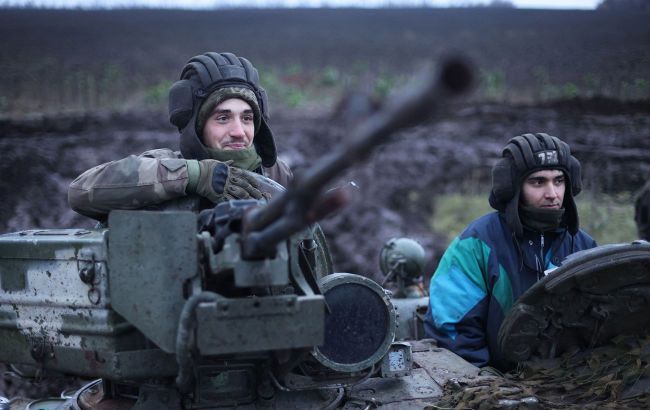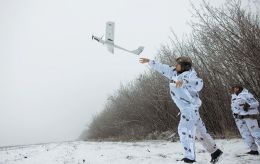Russian army will struggle to attack due to weather and maneuvering challenges - ISW
 Photo: the Russian military will not be able to seriously advance on any of the directions of the front (Getty Images)
Photo: the Russian military will not be able to seriously advance on any of the directions of the front (Getty Images)
Recently, Russian forces have initiated offensive operations, attempting to capitalize on two windows of opportunity—the upcoming spring thaw and challenges in providing Western assistance to Ukraine. However, this will not provide the aggressor with significant operational advantages or enable swift maneuvering over large territories, according to a report by the Institute for the Study of War (ISW).
Ukraine is approaching the spring period when the frozen winter ground thaws, making the movement of mechanized equipment across the entire theater of operations more challenging. This slows down (but does not completely halt) offensive operations along the front line, according to the report.
Impact of weather on military operations
Some Russian bloggers are already noting that the spring condition of the land in southern Ukraine hinders the transfer of new reserves to the Zaporizhzhia region to reinforce the Defense Forces and counter Russian offensive efforts. These weather conditions are likely to also slow down the pace of the Russian advance as the weather becomes warmer.
"Russian forces are likely trying to secure tactical advances throughout the theater while the terrain and weather generally favor offensive movement in order to exhaust and attrit defending Ukrainian forces as well as to secure favorable positions for future operations before the rasputitsa (the mud season - ed.) begins in earnest," according to the ISW report.
Furthermore, the Russian military command likely recognizes that security assistance from European partners to Ukraine, including promised European deliveries of artillery ammunition, will start to have an effect in the medium term, possibly by the fall of 2024. Therefore, Russia is attempting to exploit the current "ammunition shortage" in Ukraine to exert pressure on Ukrainian forces across the entire theater of operations while the Ukrainian Armed Forces experience a relative (but likely temporary) deficit in artillery.
"The eventual provision of more European security assistance to Ukraine, however, will not fill the gap in critical equipment that the full cessation of US military assistance would create, particularly with advanced air defense systems such as Patriot surface-to-air missiles. The scaling-up of European security assistance is necessary but not sufficient for Ukrainian forces to stabilize the front, let alone to regain the initiative in areas where Russian forces are pressing," as stated in the ISW report.
Outcome with colossal losses
The Institute for the Study of War also summarized the results of the Russian operation to capture Avdiivka. It is noted that over four months, the aggressor's forces managed to advance nearly nine kilometers.
However, during this period, the invaders suffered colossal losses. The commander of the Tavria Operational Strategic Group, Brigadier General Oleksandr Tarnavskyi, mentioned that it included 47,000 personnel, 364 tanks, 248 artillery systems, 748 combat armored vehicles, and five aircraft.
"Russian forces were also unable to complete a full operational encirclement of Avdiivka within that four-month window, and Ukrainian forces appear to have been able to withdraw in mainly good order," stated the ISW report.
A Russian military blogger and volunteer from the 4th Motorized Rifle Brigade (2nd Army Corps of the LNR) provided insights into the pace of Russian losses compared to the territories gained on February 17. According to the blogger, even some Russian sources acknowledge the exceptionally high cost paid for these limited Russian gains.
The blogger claims that Russian forces have suffered 16,000 "irreversible losses" (presumably killed in action, while Tarnavskyi's estimate may also include wounded) on the Avdiivka front since October 2023. The blogger sarcastically noted that the tank regiments and tank divisions assaulting Avdiivka have "distinguished themselves" by advancing only a few kilometers in four months and sustaining mass personnel losses.
In contrast, according to the Russian blogger, Ukrainian forces suffered much fewer losses and could withdraw to prepared defensive positions mostly on their own terms. This, according to the blogger, means that the exhausted Russian forces will have to engage with Ukrainian forces again on new lines.
Meanwhile, according to the ISW report, Russian forces managed to draw Ukrainian forces to Avdiivka and other front sectors, forcing Ukrainians to use their already limited critical equipment supplies. However, they achieved this without securing significant operational advantages. This likely foreshadows similar outcomes in the ongoing offensive operations along the border between the Kharkiv and Luhansk regions, as well as in the western part of the Zaporizhzhia region.
Phantom advantages and Russian maneuvers
Experts from the Institute for the Study of War note that Russian forces have yet to demonstrate the ability to secure significant operational advantages or conduct rapid mechanized maneuvers over large territories, and the capture of Avdiivka should not be seen as a demonstration of such capability.
"ISW distinguishes between tactical gains, relevant at the tactical level of war in the near vicinity of the fighting, and operational gains, which are significant at the operational level of war and affect large sectors of the entire front line. When ISW assesses that a given advance has or has not made “operationally significant” gains, we are referring to this distinction. Since the intensification of Russian offensive efforts in Avdiivka in October 2023, Russian forces managed to traverse fewer than 10 kilometers through and around Avdiivka," as stated in the report.
However, ISW points out that Avdiivka is located nearly 60 kilometers from the border with the Donetsk region. Russian forces would need to conduct extensive and skillful maneuvers in challenging terrain to reach the borders of the oblast in less than a few years and move even further through more fortified territory to reach the Slovyansk-Kramatorsk area in the northern part of the Donetsk region.
"Russian forces have not displayed the capability to conduct such maneuvers, either near Avdiivka or in any other front sector. Russian offensive efforts to take Kupiansk could plausibly force Ukrainians to the left bank of the Oskil River, but Russian forces in this area have remained largely impaled on small tactical positions in the Kupiansk direction for months. Russian offensive efforts south of Orikhiv are unlikely to advance past Orikhiv itself or even to reach Orikhiv quickly, given the climatological challenges discussed above," as stated in the ISW report.
Current situation on the front
Positional battles continue on the southwest of Avdiivka, to the west and southwest of Donetsk, in the areas of Bakhmut, Krynky, and near Kreminna. Ukrainian defense forces are holding back the assaults of Russian occupiers near Robotyne.
According to the General Staff of the Armed Forces of Ukraine, as of the evening of February 18, there have been 56 combat clashes on the front line within the past day.
Russian military attempted to storm the village of Lastochkyne to the west of Avdiivka, but the defense forces repelled 14 enemy attacks.
ISW experts believe that the defense forces will be able to establish new defensive lines near the city, leading to the culmination of the Russian advance in this section of the front.
To understand the implications of the withdrawal of the Armed Forces of Ukraine from Avdiivka and how it will affect the situation on the front, read the material by RBC-Ukraine.

